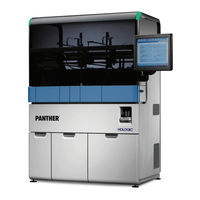
Hologic Panther System Diagnostic Manuals
Manuals and User Guides for Hologic Panther System Diagnostic. We have 1 Hologic Panther System Diagnostic manual available for free PDF download: Operator's Manual
Hologic Panther System Operator's Manual (425 pages)
Brand: Hologic
|
Category: Laboratory Equipment
|
Size: 6.97 MB
Table of Contents
-
Terminology30
-
Compliance33
-
Safety33
-
Limitations41
-
Overview52
-
Introduction56
-
Canopy58
-
Reagent Bay60
-
Fluid Pumps62
-
Incubators64
-
Distributor65
-
Luminometer65
-
Output Queue66
-
Computer67
-
Naocl Bottle68
-
Vacuum Pump68
-
Printer69
-
Introduction69
-
Login Screen70
-
Menu Bar72
-
Status Panel74
-
Tasks Screen83
-
Results Screen100
-
Change Password111
-
Help Window116
-
System Operation119
-
System Startup119
-
Login/Logoff119
-
Login119
-
Logoff120
-
System Operation120
-
Load Tips121
-
Load Mtus124
-
Empty Waste128
-
Prime Instrument131
-
Prime Criteria132
-
Prime Procedure133
-
Force Full Prime133
-
Master Lot Setup133
-
Load Samples140
-
Sample Defaults144
-
Dilution Factors154
-
System Leds158
-
System Alarm160
-
Status Panel164
-
Specimen Status173
-
Specimens Panel175
-
Viewing Results177
-
Result Details180
-
User Comment181
-
Filter Results181
-
Data Export183
-
Printing Reports190
-
Reports192
-
Results Report209
-
System Shutdown214
-
Maintenance216
-
Mag Wash Clean227
-
Idle Maintenance237
-
Database Backup238
-
Database Restore239
-
Delete Database239
-
Manual Download241
-
Batch Loading242
-
Purge Logs243
-
Purge Results244
-
Configuration245
-
User Interface246
-
Waste Threshold247
-
Specimen Loading251
-
UPS Management261
-
LIS Messages266
-
Change Password270
-
Troubleshooting281
-
Assay Versions284
-
Silence Alarm285
-
Force MTU Unload285
-
Send Logs286
Advertisement
